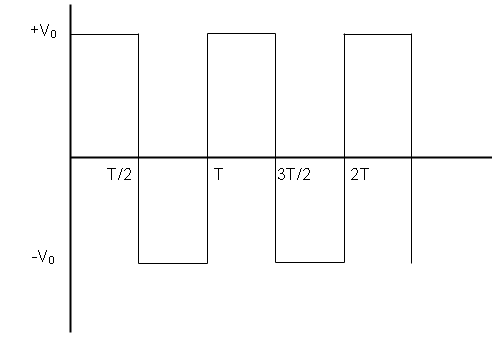
The average and RMS value of voltage for square waves shown in the fig. having a peak value ${V_0}$ are:

(A) $\dfrac{{{V_0}}}{{\sqrt 2 }},\sqrt 2 {V_0}$
(B) $\sqrt 2 {V_0},\dfrac{{{V_0}}}{{\sqrt 2 }}$
(C) ${V_0},{V_0}$
(D) Zero, ${V_0}$
Answer
216.6k+ views
Hint: In this solution, we will use the formula of average and RMS value. We only need to consider one cycle of the voltage to calculate the average and RMS value.
Complete step by step answer:
In the graph given to us, we want to calculate the average and RMS value of voltage.
The average amplitude is the mathematical “mean” of all a waveform’s points over the period of one cycle. It can be mathematically calculated as:
${V_{avg}} = \dfrac{1}{T}\int {{V_0}dt} $
We can see that the waveform of the voltage starts a cycle at $t = 0$ and ends the cycle at $t = T$. To calculate the integral of the wave function given to us, we need to break the integral down into regions where the voltage has constant values. So, we can write
${V_{avg}} = \dfrac{1}{T}\left( {\int\limits_{t = 0}^{t = T/2} {{V_0}dt + } \int\limits_{t = T/2}^{t = T} { - {V_0}dt} } \right)$
The ${V_0}$ term can be taken out of the integral since it is constant. The integral can then be simplified to
${V_{avg}} = \dfrac{{{V_0}}}{T}\left( {\dfrac{T}{2} + \dfrac{T}{2} - T} \right)$
$ \Rightarrow {V_{avg}} = 0$
Hence the average voltage will be zero.
Now, The RMS value stands for Root Mean Square value. It is a way of expressing an AC quantity of voltage or current in terms functionally equivalent to DC. It can be mathematically calculated as
${V_{RMS}} = \sqrt {\dfrac{1}{T}\int\limits_{t = 0}^T {{V^2}dt} } $
The integral can be broken into two parts as
${V_{RMS}} = \sqrt {\dfrac{1}{T}\left( {\int\limits_{t = 0}^{t = T/2} {V_0^2dt} + \int\limits_{t = T/2}^{t = T} {V_0^2dt} } \right)} $
The integral can be simplified as
${V_{RMS}} = \sqrt {\dfrac{{{V_0}^2}}{T}T} $
Or,
${V_{RMS}} = {V_0}$
Hence the correct choice is option (D).
Note: While calculating the average and the RMS value, we must not forget the $1/T$ term outside the integral. We can also find the average value graphically as zero since the area of the graph for one time period is the same in the positive and negative regime and as such, the average value will be zero.
Complete step by step answer:
In the graph given to us, we want to calculate the average and RMS value of voltage.
The average amplitude is the mathematical “mean” of all a waveform’s points over the period of one cycle. It can be mathematically calculated as:
${V_{avg}} = \dfrac{1}{T}\int {{V_0}dt} $
We can see that the waveform of the voltage starts a cycle at $t = 0$ and ends the cycle at $t = T$. To calculate the integral of the wave function given to us, we need to break the integral down into regions where the voltage has constant values. So, we can write
${V_{avg}} = \dfrac{1}{T}\left( {\int\limits_{t = 0}^{t = T/2} {{V_0}dt + } \int\limits_{t = T/2}^{t = T} { - {V_0}dt} } \right)$
The ${V_0}$ term can be taken out of the integral since it is constant. The integral can then be simplified to
${V_{avg}} = \dfrac{{{V_0}}}{T}\left( {\dfrac{T}{2} + \dfrac{T}{2} - T} \right)$
$ \Rightarrow {V_{avg}} = 0$
Hence the average voltage will be zero.
Now, The RMS value stands for Root Mean Square value. It is a way of expressing an AC quantity of voltage or current in terms functionally equivalent to DC. It can be mathematically calculated as
${V_{RMS}} = \sqrt {\dfrac{1}{T}\int\limits_{t = 0}^T {{V^2}dt} } $
The integral can be broken into two parts as
${V_{RMS}} = \sqrt {\dfrac{1}{T}\left( {\int\limits_{t = 0}^{t = T/2} {V_0^2dt} + \int\limits_{t = T/2}^{t = T} {V_0^2dt} } \right)} $
The integral can be simplified as
${V_{RMS}} = \sqrt {\dfrac{{{V_0}^2}}{T}T} $
Or,
${V_{RMS}} = {V_0}$
Hence the correct choice is option (D).
Note: While calculating the average and the RMS value, we must not forget the $1/T$ term outside the integral. We can also find the average value graphically as zero since the area of the graph for one time period is the same in the positive and negative regime and as such, the average value will be zero.
Recently Updated Pages
JEE Atomic Structure and Chemical Bonding important Concepts and Tips

JEE Amino Acids and Peptides Important Concepts and Tips for Exam Preparation

Electricity and Magnetism Explained: Key Concepts & Applications

Chemical Properties of Hydrogen - Important Concepts for JEE Exam Preparation

JEE Energetics Important Concepts and Tips for Exam Preparation

JEE Isolation, Preparation and Properties of Non-metals Important Concepts and Tips for Exam Preparation

Trending doubts
Understanding Electromagnetic Waves and Their Importance

Understanding the Wheatstone Bridge: Principles, Formula, and Applications

Formula for number of images formed by two plane mirrors class 12 physics JEE_Main

Step-by-Step Guide to Young’s Double Slit Experiment Derivation

Geostationary and Geosynchronous Satellites Explained

Inertial and Non-Inertial Frame of Reference Explained

Other Pages
MOSFET: Definition, Working Principle, Types & Applications

Explain the construction and working of a GeigerMuller class 12 physics JEE_Main

Electric field due to uniformly charged sphere class 12 physics JEE_Main

Clemmensen and Wolff Kishner Reductions Explained for JEE & NEET

Diffraction of Light - Young’s Single Slit Experiment

JEE Main 2023 January 29th Shift 2 Physics Question Paper with Answer Keys and Solutions




